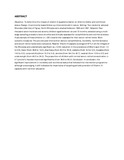Vitamin A supplementation on child morbidity

Date
2003Author
Haidar, J
Tsegaye, D
Mariam, D H
Tibeb, H N
Muroki, N M
Type
ArticleLanguage
enMetadata
Show full item recordAbstract
Objective: To determine the impact of vitamin A supplementation on child morbidity and nutritional status.
Design: A community based follow-up (interventional) in nature.
Setting: Two randomly selected Weredas (districts) of Tigray, North Ethiopia were studied between 1996 and 1997.
Subjects: Four thousand seven hundred and seventy children aged between six and 72 months, selected using a multi-stage sampling procedure were enrolled and clinically assessed for xerophthalmia and nutritional status. A sub-sample of these children (n = 281) was further assessed for their serum retinol levels.
Main outcome measures: The pre and post intervention data on xerophthalmia, morbidity, nutritional status and serum retinol levels were compared.
Results: Vitamin A capsule coverage of 87% in all the villages of the Weredas and a statistically significant (p < 0.05) reduction in the prevalence of Bitot's spot (from 1.5 to 0.5), fever (from 29.8 to 14.2), diarrhoea (from 30.2 to 18.2), oedema (from 9.2 to 3.2), measles (from 14.0 to 6.2), conjunctivitis (from 10.2 to 3.0), stunted (from 64.2 to 42.7), wasted (from 12.8 to 2.5) and underweight (from 46.2 to 24.2). The proportion of children with normal serum retinol concentration (> 0.7 µmole/L) has also improved significantly (from 36.8 to 56.2).
Conclusion: In conclusion, the significant improvement in morbidity and nutritional status that followed the intervention programme although encouraging, it still indicates the importance of coupling periodic provision of Vitamin A capsules with nutrition education.
URI
http://www.ajol.info/index.php/eamj/article/view/8660http://erepository.uonbi.ac.ke:8080/xmlui/handle/123456789/54308
Citation
(East African Medical Journal: 2003 80(1): 17-21)Publisher
University of Nairobi Department of Food Science, Nutrition & Technology
